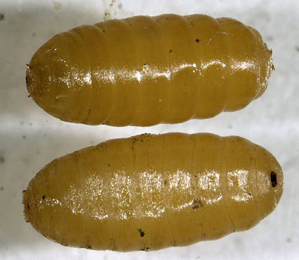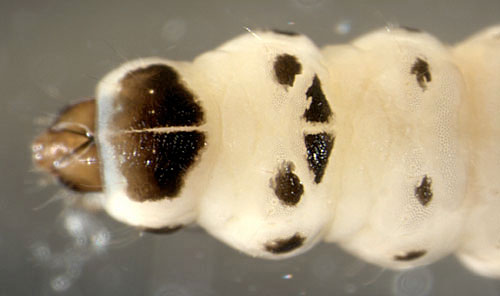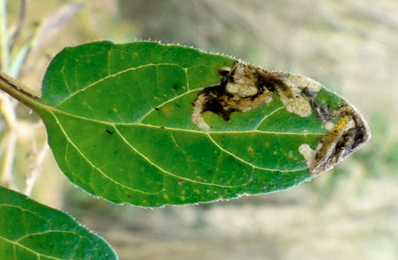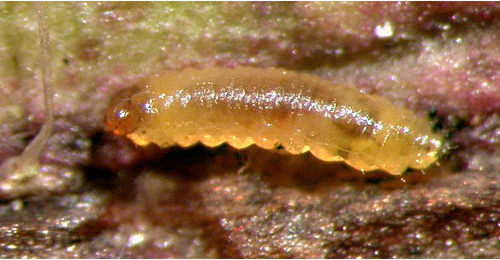|
||||
|
LEUCANTHEMUM. Oxeye Daisy [Asteraceae] |
|
|
Five species of Leucanthemum are recorded in Britain. These include the native Oxeye Daisy (L. vulgare). Thirteen or fourteen Biritsh miners are recorded on Leucanthemum. The agromyzid Melanagromyza eupatorii is recorded boring the stems of Leucanthemum in Britain and elsewhere. A key to the European miners recorded on Chrysanthemum including Leucanthemum is provided in Bladmineerders van Europa. |
 Oxeye Daisy Leucanthemum vulgare |
|
Key for the identification of the known mines of British |
||
|
Note: Diptera larvae may live in a corridor mine, a corridor-blotch mine, or a blotch mine, but never in a case, a rolled or folded leaf, a tentiform mine or sandwiched between two more or less circular leaf sections in later instars. Pupation never in a cocoon. All mining Diptera larvae are leg-less maggots without a head capsule (see examples). They never have thoracic or abdominal legs. They do not have chewing mouthparts, although they do have a characteristic cephalo-pharyngeal skeleton (see examples), usually visible internally through the body wall. The larvae lie on their sides within the mine and use their pick-like mouthparts to feed on plant tissue. In some corridor miners frass may lie in two rows on alternate sides of the mine. In order to vacate the mine the fully grown larva cuts an exit slit, which is usually semi-circular (see Liriomyza huidobrensis video). The pupa is formed within the hardened last larval skin or puparium and as a result sheaths enclosing head appendages, wings and legs are not visible externally (see examples). See Key to non-Diptera. |
||
|
1a > Leaf-miner: Corridor mine primarily following the mid-rib. |
||
|
1b > Leaf-miner: Corridor mine not primarily following the mid-rib. |
||
|
2 > Leaf-miner: A distinctive mine primarily above mid-rib, with irregular short lateral offshoots into leaf blade. Pupation external (Spencer, 1972: 51 (fig. 172), 55; Spencer, 1976: 270, 271 (fig. 486)). Branched, whitish, upper-surface corridor; main axis overlying the midrib; side branches overlying the main lateral veins. (In Campanula and Phyteuma the mine is much less branched, sometimes nothing more than a corridor on top of the midrib). Frass in rather long strings. Usually the mines begins as a long and narrow, shallow, tortuous lower-surface corridor that ends upon the midrib but otherwise is not associated with the leaf venation. Often this initial corridor is filled with callus, and then even less conspicuous. Pupation outside the mine. A linear mine on the upper surface, usually following the midrib and showing side branches along the veins. The frass is in strings. |
||
|
||
|
||
|
Liriomyza strigata (Meigen, 1830) [Diptera: Agromyzidae]. |
||
|
3a > Leaf-miner: Mine irregularly linear, whitish, distinctly widening, most frequently on lower leaves. Pupation external (Spencer, 1972b: 79). Long, slender corridor, gnerally upper-surface with a lower-surface beginning. Frass in irregular, but not conncted, grains. Pupation outside the mine. A long, irregular galley which widens distinctly, upper surface, but often starting lower surface and sometimes forming a secondary blotch. Most frequently on lower leaves. |
||
|
||
|
Phytomyza leucanthemi Hering, 1935 [Diptera: Agromyzidae]. |
||
|
3b > Leaf-miner: Mine linear, whitish, both upper and lower surface. Pupation internal, at the end of the mine with the anterior spiracles projecting through the epidermis (Spencer, 1976: 433). Upper-surface, less often lower-surface corridor. Frass in isolated grains. Pupation within the mine, in a, usually lower-surface, pupal chamber. A long whitish upper surface corridor, which eventually goes lower surface. |
||
|
||
|
Chromatomyia horticola (Goureau, 1851) [Diptera: Agromyzidae] |
||
|
3c > Leaf-miner: Mine linear, long, frequently doubling back, initially on the underside, later chiefly on upper surface; frass in discrete grains; forming a loose string initially, later more irregular. Pupation in the mine (Godfray, 1985). |
||
|
||
|
Chromatomyia paraciliata Godfray, 1935 [Diptera: Agromyzidae]. |
||
|
3d > Leaf-miner: A linear mine, frequently on lower surface at beginning; frass with closely adjoining grains. Upper-surface, often brownish, corridor, in the end often occupying the width of a leaf segment. Older segments of the mine are much less conspicuous, lower-surface and quite shallow. Where upper- and lower-surface stretches overlap transparent patches occur, when the leaf is illuminated from behind. Frass in isolated grains, sometimes locally pearl chains. Pupation outside the mine. |
||
|
||
|
Phytomyza tanaceti Hendel, 1923 [Diptera: Agromyzidae]. |
||
|
3e > Leaf-miner: The mine begins as a long, quite narrow corridor, usually not far from the tip of a leaf segment. Usually this corridor follows the leaf margin for some distance, but it may also run freely through the blade and may then be stongly contorted. In the end the corridor is directed towards the midrib, where an elongated blotch is formed, overlying the midrib and some of the larger lateral veins. Frass in a nearly continuous line in the initial corridor, in scattered lumps in the later part of the mine. Primary and secondary feeding lines very conspicuous when seen in transparancy. Pupation outside the mine. The mine starts as a very narrow corridor, usually close to the tip of a leaf segment and following the leaf margin. The later section of the corridor approaches the main vein, where an elongated blotch is made with long broad finger like extensions that lay over the secondary veins. In the initial corridor the frass forms an almost continuous line, in the blotch it is distributed in large scattered lumps. In fresh mines the secondary feeding lines are clearly visible. |
||
|
||
|
Trypeta zoe Meigen, 1826 [Diptera: Tephritidae]. |
||
|
3f > Leaf-miner: The mine begins as an elongated blotch overlying a strong vein; from there broad tunnels radiate that coalesce in the end. All frass is concentrated at a central point in the floor of the mine. As a result the mine has a brownish-black centre and a paler brownish green seam. The larva often (perhaps always at daylight) rests in the centre of the mine. Primary and secondary feeding lines as a rule quite clear. Pupation outside the mine. An elongated blotch centred over a vein. There are two types: greenish with a blackish centre and entirely reddish-black. |
||
 Trypeta artemisiae pupariria Image: © Willem Ellis (Bladmineerders van Europa) |
||
|
||
|
Trypeta artemisiae (Fabricius, 1794) [Diptera: Tephritidae]. |
||
|
Key for the identification of the known mines of British |
|
Note: The larvae of mining Coleoptera, Hymenoptera and Lepidoptera may live in a corridor mine, a corridor-blotch mine, a blotch mine, a case, a rolled or folded leaf, a tentiform mine or sandwiched between two more or less circular leaf sections in later instars. Larva may pupate in a silk cocoon. The larva may have six legs (although they may be reduced or absent), a head capsule and chewing mouthparts with opposable mandibles (see video of a gracillarid larva feeding). Larvae of Hymenoptera and Lepidoptera usually also have abdominal legs (see examples). Frass, if present, never in two rows. Unless feeding externally from within a case the larva usually vacates the mine by chewing an exit hole. Pupa with visible head appendages, wings and legs which lie in sheaths (see examples). |
1a > Leaf-miner and case-bearer: The larva lives outside the mine, protected by a case, and feeds on the underlying plant tissues via a hole cut in the epidermis. From that point it eats away as much leaf tissue as it can reach without fully entering the mine. Mine does not contain frass (Coleophora species). |
1b > Leaf-miner, but not a case-bearer: The larva lives mainly inside the mine. Mine usually contains frass. In later instars the larva may live sandwiched between two more or less circular sections cut from the leaf. |
2a > Leaf-miner and case-bearer: Larva mines leaves. On Eupatorium the case is extended at the anal end by adding silk and widened by cutting a ventral gusset. On Inula the case is firstly extended by adding rings of leaf-cuticle at the oral end, before reverting to the method used when on Eupatorium. The full-grown case is 10 mm long. A slender tubular silken case, about 10 mm long, straw coloured, three valved. Mouth angle about 30°. |
 Coleophora folicularis larva, dorsal Image: © Willem Ellis (Bladmineerders van Europa) |
|
Coleophora follicularis (Vallot, 1802) [Lepidoptera: Coleophoridae]. |
2b > Leaf-miner and case-bearer: A straw-coloured to grey, slender, three-valved case of he type tubular silken case; mouth angle 45° - 60°. The case resembles that of C. trochilella, but the case is more slender, the mouth is narrower and the constriction behind the mouth less deep. |
|
|
Coleophora gardesanella Toll, 1954 [Lepidoptera: Coleophoridae]. |
2c > Leaf-miner and case-bearer: A straw-coloured, slender, three-valved tubular silken case; length about 10 mm, mouth angle 45° - 60°. Larva on the leaf underside. Perhaps because of the plant's dense felt cover, the case is attached with much silk, giving the holes a conspicuous white margin. |
|
|
Coleophora trochilella (Duponchel, 1843) [Lepidoptera: Coleophoridae]. |
3a > Leaf-miner: The larvae mine the leaves creating a long, meandering gallery containing narrow blackish frass. In later instars, the larva feeds externally. Young larvae in a very long, hair thin, winding corridor. Usually the corridor is (largely) upper-surface. Frass initially in a narrow continuous central line; further on the frass line is often interrupted. Older larvae live free and cause window feeding, usually at the leaf underside. |
|
|
Bucculatrix nigricomella (Zeller, 1839) [Lepidoptera: Bucculatricidae]. |
3c > Leaf-miner: Rather narrow corridor, untidy and sometimes branched, starting from the base of the leaf, in particular the midrib. Sides of the corridor irregularly eaten out, not really parallel. Frass mostly present, and then in a central line. The larva is capable of leaving the mine and start a new one elsewhere. These later mines are much broader, and the frass is scattered irregularly.. |
 Mine of Orthochaetes insignis on Prunella vulgaris Image: © Jean-Yves Baugnée (Bladmineerders van Europa) |
|
Orthochaetes insignis (Aube, 1863) [Coleoptera: Curculionidae]. |
3b > Leaf-miner: Rather narrow corridor, untidy and sometimes branched, starting from the base of the leaf, in particular the midrib. Sides of the corridor irregularly eaten out, not really parallel. Frass mostly present, and then in a central line. The larva is capable of leaving the mine and start a new one elsewhere. These later mines are much broader, and the frass is scattered irregularly.. |
|
Orthochaetes insignis (Aube, 1863) [Coleoptera: Curculionidae]. |
3c > Leaf-miner: The mine begins in the midrib, especially in a lower leaf, extending into the leaf disc, branching irregularly or pinnately, may also locally be blotch like. The mine is brown and very transparent. Sides very irregularly eaten out. Frass loosely dispersed or in a loose central line, buy may also be pressed against the sides of the corridor. The larva may also leave the mine and restart elsewhere. |
 Orthochaetes setiger larva, dorsal Image: © Jean-Yves Baugnée (Bladmineerders van Europa) |
|
Orthochaetes setiger (Beck, 1817) [Coleoptera: Curculionidae]. |
|
|
||
| Last updated 09-Jul-2020 Brian Pitkin | ||
|
|
||

